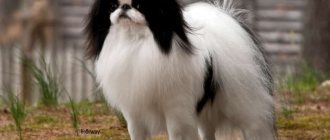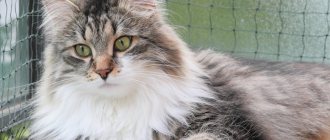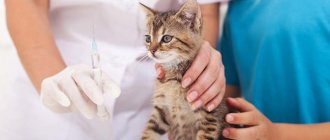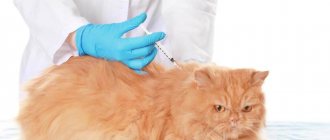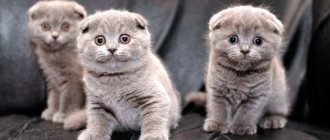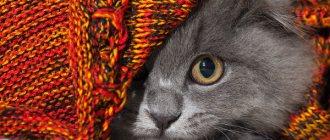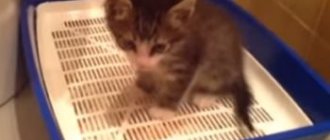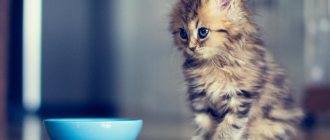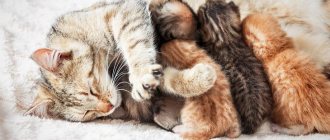Every pet unfortunately ages over time. Over time, the cat cannot properly care for itself, and its metabolism decreases. The owner’s task is to change the conditions of detention and delve into some of the features of caring for an aging animal. The greatest attention should be paid to the quality of nutrition and body weight of the animal.
Any changes in the body negatively affect the condition of the cat’s body and can shorten its lifespan. Excess body weight creates an increased load on the pet’s cardiovascular system, also affecting the organs of the respiratory system and musculoskeletal structures.
Lack of body weight also leads to serious consequences, causing exhaustion of the body. If your cat is not eating well, the cause may be changes in the sensory system. In this regard, secondary changes occur, the sensitivity of taste buds and receptors responsible for smell is weakened.
Decreased visual acuity and hearing
The first thing that cat owners pay attention to as they age is a decrease in hearing and visual acuity. This is indicated by a number of symptoms:
- Disorientation in familiar space. Increasingly, the cat bumps into furniture and cannot follow the movement of household members and objects.
- Lack of response to loud, annoying sounds.
- The cat does not respond to its name, does not run to the sound of food being poured into a bowl.
- Changes in behavior and the manifestation of aggressive traits are a symptom of hearing loss. This happens for the reason that the cat does not hear the owner approaching her and gets scared.
Owner actions. To help your pet you need to:
- Change the location of the tray and food bowl to make it easier for the animal to navigate.
- Provide the cat with maximum comfort, both moral and physical, and spend more time with her.
- Do not sneak up on your pet from behind, do not get angry if he does not respond to his name. Pets are good at feeling the mood of their owners.
It is imperative to consult a veterinarian. A specialist can prescribe drops for the eyes, ears, and vitamins that help prevent the worsening of pathological processes.
No unsupervised walks
Keeping your pet outdoors increases your chances of getting wounds and infectious diseases such as feline leukemia and feline immunodeficiency virus. A more obvious danger lies in other aggressive cats and dogs, as well as in cars passing nearby. An older cat finds it more difficult to cope with life situations, and its reaction to stimuli becomes less active.
If your adult cat is used to walking outside and often asks to go outside, train her to use a leash. Walking accompanied by the owner is much safer, because the animal is under constant supervision. A leash can be stressful for some cats. In order for your pet to feel comfortable, it is important to accustom it to a leash in a familiar environment – at home. After the cat gets used to it, take it outside, taking some goodies with you.
Wool and skin
Aging cats experience a number of problems with their skin and fur. It should be understood that the changing condition of the coat not only looks unsightly, but also brings a lot of discomfort to the animal:
- Thinning, excessive dryness and flaking of the skin are accompanied by severe and frequent itching. Due to frequent and severe scratching, abrasions and wounds may appear on the epidermis.
- Long-term healing of skin lesions.
- The coat becomes dull, may turn gray and fall out.
- Formation of multiple mats.
How to help ? The owner will be required to perform certain actions:
- Frequent and thorough combing of the coat with special brushes. When combing a fur coat, it is recommended to carefully inspect the skin each time. If any lumps or bumps are noticed on it, this is a reason to immediately contact a veterinarian, since as cats age, there is a high risk of developing cancerous tumors that last for a long time without any symptoms.
- Adding vitamins to the diet to help normalize the condition of the coat and its appearance.
- Treating wounds with disinfectants and applying healing ointments. If the wound on the skin is deep and the cat often scratches it, use topical preparations containing an antibiotic.
Claw care. The animal's claws require no less attention. With age, the nail plate becomes thin and brittle. At the same time, the claws continue to actively grow, but the pet stops regularly grinding them down. Owners need to monitor the length of the cat’s claws and, if necessary, cut them with special scissors.
Good to know
- Why Cats Hide That They're Hurt
- Savannah or Serval cats
- Feline urinary retention in cats: a real emergency. Helping a cat who can't urinate
- 8 Causes of Pain in Domestic Cats. An Approach to Recognizing and Providing Therapeutic Care to Your Pet
- Orofacial pain syndrome in cats (causes, pathogenesis, diagnosis and therapy)
- Catnip for cats (uses, similar plants). The world of smells in the animal world
- Why does the cat sneeze?
Teeth and oral cavity
Veterinarians recommend brushing your cat's teeth once every 2 weeks.
For the procedure, a special toothbrush and toothpaste are used, which can be purchased at a pet store. The peculiarity of toothpaste for animals is that it does not need to be washed off with water.
Not all cats like to have their teeth brushed. If the animal reacts inadequately to this procedure, it is recommended to purchase specialized dry food that helps keep the oral cavity clean.
Mobility and games
An aging cat prefers to spend most of its time lying down. But activity and mobility are the key to ensuring that your pet will not have problems with the musculoskeletal system.
The most common disease in older cats is arthritis.
It and a number of other pathologies can be prevented by following medical recommendations:
- Regular games with your pet are required . Even an elderly cat will not refuse to spend time with its owner playing actively with its favorite toy. But you can't overdo it with activity. It should be remembered that the animal gets tired quite quickly.
- Limiting contact with children . If there are small children in the house, it is recommended to protect the cat from frequent contact with them. Elderly pets need peace and quiet. If children frequently tug on your pet, this can cause severe stress, which will further worsen the health condition.
- Arranging a home to suit the needs of an aging pet . Trays, bowls, and the cat's sleeping place should be within easy reach.
- Preventing cats from walking up stairs . It will be difficult for the animal to do this.
- It is important to pay special attention to the litter tray. Many cats find it very difficult to get into a tray with high sides as they age. In such cases, the pet has no choice but to relieve itself near him. You should not scold the animal. It is necessary to purchase a tray with the lowest possible sides.
Regular preventive measures
A common problem in animals is internal and external parasites, so the main attention should be paid to preventive measures. For prevention use:
- Anthelmintic drugs. They have a wide spectrum of action to protect against various types of helminths. Used for the prevention of nematodes and cestodes.
- Anti-flea collars. If a cat is infected with fleas, it is first important to get rid of them, and after 3-4 days put on a collar that will provide protection against fleas for up to four months.
- Drops against ticks. They are necessary for those cats that are often outdoors. The effect of the drops lasts for 1-2 months.
By taking preventive actions, you can avoid many diseases that are difficult for older cats to tolerate.
Nutritional Features
Just like humans, cats experience some digestive problems as they age. Changing a cat's diet is always a big stress.
In order not to subject the animal to such a test as a sudden change in the daily menu, veterinarians advise changing the diet starting from the age of 7.
And this needs to be done gradually.
Owners of older cats will have to deal with various features of their digestion:
- Slow digestion of food, intolerance to heavy meals and poor absorption of nutrients.
- Inability to eat food that is served in large pieces.
- Non-acceptance of many previously familiar foods by the digestive system.
- Stool disorders, manifested in the form of frequent constipation or diarrhea.
- Nausea and vomiting.
- Dysbacteriosis.
- Bloating.
- Weight loss or, on the contrary, rapid weight gain.
All of these symptoms cause a lot of inconvenience and anxiety not only for the cat, but also for the owner.
Solving problems with the gastrointestinal tract. To protect your cat from problems with the digestive system, you must follow the appropriate recommendations and rules:
- Consultation . The most correct way to organize nutrition for an elderly pet is to consult a veterinarian. The specialist will diagnose the state of the digestive system and select nutrition in such a way as to prevent the development of diseases if there is a risk of their occurrence.
- Fractional meals . Older cats prefer to eat little but often. The recommended frequency of serving food is 3 to 4 times a day.
- Serving food . The food is crushed because cats will not be able to chew large pieces. For better digestibility, it is recommended to warm the food a little.
- Vitamin supplements . Cats that are accustomed to eating only natural products should, in addition to them, receive special vitamins intended for older individuals.
- Serving meat dishes . They should always be supplemented with mineral complexes.
- Supplements . A small amount of vegetable oil should be added to vegetable and fermented milk dishes. Just 1 drop is enough. Recommended oils are olive, flaxseed or corn.
- Replacement of feed . The industrial food familiar to the animal must be replaced with specialized dry food appropriate for old age.
- Prohibited Products: fatty and heavy foods, sweets and confectionery, baked goods and baked goods, fried and salty foods, marinades.
In addition, owners should ensure that the pet regularly drinks enough water.
Obesity
A sedentary lifestyle, a slower metabolism and a number of age-related changes in the functioning of the digestive system are factors that provoke the development of obesity in an elderly cat. Neutered pets are especially susceptible to this. Obesity causes many serious diseases in cats: diabetes, kidney and liver problems.
To avoid rapid weight gain, it is necessary to feed your pet the right, healthy and low-calorie foods, and provide specialized food for older cats. Don’t forget about regular but moderate physical activity and outdoor games.
Signs that a cat is getting old
Because your cat's immune system is not as resilient as it once was, it is important for you, the conscientious cat owner, to monitor for any signs of developing health problems. Here are some of the most common health problems in older animals.
- Arthritis
- Cancer and other oncological diseases
- Cognitive disorders
- Constipation
- Deafness
- Dental diseases
- Diabetes
- Heart diseases
- Hyperthyroidism
- Inflammatory bowel disease
- Kidney disease
- Retinal diseases/vision problems
Thermoregulation
Paying a lot of attention to the cat's nutrition and appearance, most owners forget about such an important point as thermoregulation, which is disrupted with age. Pets become more sensitive to cold and drafts, and they find it more difficult to tolerate too high temperatures. It is quite possible to help an animal if:
- Monitor the temperature in the house. Both cold and extremely high temperatures should be avoided.
- Set up a warm place to sleep. In winter, it is recommended to move the cat bed closer to the radiator and other heat sources.
- After bathing, thoroughly dry the coat with a towel and dry it with a hairdryer.
In spring and autumn, the pet must be protected from being in a draft.
Heart ailments
Heart failure and other diseases of old cats associated with dysfunction of the cardiovascular system are a dangerous enemy that must be fought under the supervision of a competent specialist. Symptoms: rapid breathing, breathing with an open mouth, blue tint of mucous membranes, uneven heart rate after physical activity. Death in older cats suffering from heart disease often occurs due to stress or fear. Therefore, such a pet must be protected from any worries: children should not be allowed to bother the cat, guests should not be allowed to pet or pick up the pet, on New Year’s Eve it is imperative to use sedatives recommended by a veterinarian (louding firecrackers are the cause of deaths from heart attacks not only in the elderly, but also older cats).
Symptoms in older cats that should alert the owner
As a cat ages, the owner must closely monitor it and respond appropriately to any changes in behavior and habits. Any deviations indicate the presence of certain diseases and pathological processes that can occur for a long time without pronounced symptoms:
- Increased thirst . If the cat begins to frequently approach the bowl of water, regardless of the ambient temperature, this indicates a possible abnormality in the functioning of the pancreas or kidneys. You need to immediately consult a doctor for a detailed diagnosis.
- Sudden change in appetite . This manifests itself in different ways. Some animals may refuse to eat at all, although at first they will run to the bowl. This sign indicates possible diseases of the oral cavity. The cat wants to eat, but the process of chewing food causes pain.
- Disturbance in the process of urination . The cat began to run to the litter box too often, and the owner noticed that the daily amount of urine had increased. The opposite situation may also occur, when the cat does not go to the toilet for a whole day or more, the amount of urine excreted is no more than a few drops. Often the presence of blood is detected in the urine. These signs are highly likely to indicate urolithiasis, one of the most common diseases in older cats.
- Constipation . The pet does not go to the litter box for a long time, and going to the toilet causes pain, causing the animal to meow while sitting on the tray. The presence of constipation in older pets is associated with slowing and disruption of intestinal motility. You need to immediately change your diet. It is recommended to add a few drops of vegetable oil to food. If there is no positive result within a few days, you should contact your veterinarian. Giving laxatives or giving enemas without a veterinarian's prescription is strictly prohibited.
- Loss of coordination of movements . The cat bumps into pieces of furniture, its gait has become unsteady. Often, the owner may notice that the pet drifts to the side when walking. Causes: hearing and vision impairment, neurological diseases. Treatment is prescribed only by a veterinarian.
- Rapid weight loss . The reasons are an unsuitable diet, diseases of the digestive system, hormonal imbalances, and cancer.
- Deterioration in appearance, appearance of hairballs, dry skin . Old cats often stop grooming themselves. Therefore, this mission is entrusted to the owner. Another reason why a cat stops licking with age is diseases of the oral cavity, the presence of ulcerative formations on the tongue.
The owner of an elderly cat must be prepared for the fact that she may develop various diseases, sometimes very serious and requiring urgent medical attention. Symptoms that are an indication for prompt contact to a veterinary clinic are shortness of breath, increased or decreased body temperature, lethargy and apathy. These signs may indicate heart disease.
Also watch the video on how to care for an elderly cat:
Find out at what age your cat qualifies as a “Senior Pet”
Since many cats live well into their twenties, it's easy to understand why owners wonder: When does a cat actually reach old age?
Although many believe that your individual cat is as old as she feels, most cats reach advanced age status somewhere between 11 and 14 years of age. Here are the typical age ranges in which older cats reach various life stages, according to the American Association of Feline Practitioners (AAFP):

